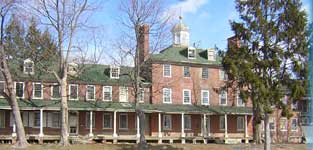Introduction
Excerpted from a report submitted to the Historic American Building Survey (HABS) by Rebecca H. Sell and "The Lazaretto: The Cultural Significance and Preservation Plan in the Spirit of the Burra Charter" by Rebecca H. Sell, A Thesis in Historic Preservation, Master of Science in Historic Preservation, University of Pennsylvania, 2005.
I. INTRODUCTION
"For the plague there is a house... two miles from Venice, called the Lazaretto."
"First, by substituting in lieu of the existing health laws (which are voluminous ambiguous and ineffectual) an energetic law for the regulation of quarantine, the erection of a lazaretto and of magazines for the reception and purification of cargoes, in a situation more secure and remote from the city."
Driving along Interstate 95, past the developed expanse of the Philadelphia International Airport on the east and the swampy marshes of the John Heinz National Wildlife Reserve to the west, most may never realize that one of our nation's most significant historic resources rests alongside the riverfront (see figures 1-7). Although the landscape and some buildings remain, time is taking its toll on their stability. Stories woven into the history of our nation have begun at this place, and it is imperative that it be preserved in order study the past, learn about the present, and plan for the future.
Nestled along the banks of the Delaware River, in the small, industrial town of Essington, of Tinicum Township, Pennsylvania, sits one of America's first quarantine stations, one of the last surviving examples of a quarantine station on the east coast and perhaps the nation. Commissioned and built by the Pennsylvania Board of Health in 1799, in response to the yellow fever epidemics of the late eighteenth century plaguing Philadelphia, the Lazaretto was strategically placed due south of the city on the banks of the Delaware River to inspect and quarantine all incoming ships, passengers, and cargo attempting to enter Philadelphia and other northern ports along the river (see figures 37-41) . It was there that all immigrants, merchants, and even citizens on incoming ships were required by law to pay a fee and be quarantined for at least a day, and sometimes weeks, in order for the ship to be inspected for sick individuals, infested cargo, or bodies of passengers that had died in transit. If disease or infestation were found, fumigation and sterilization of the ship and its contents would be conducted, the sick would be treated in the hospital onsite, and the healthy would stay in tents or housing on the premises.
Quarantine stations like these were essential at almost every major seaport throughout the nineteenth and early twentieth century. Most of these are gone, and the few that remain are either severely deteriorated or date to the turn of the twentieth century. The Lazaretto, in Tinicum Township, remains in remarkably stable condition, with a high degree of integrity, retaining its unique architectural features dating to the turn of the nineteenth century, making it the oldest of its type remaining in the country. Its design and founding concepts made it a prototype, which later quarantines mimicked. It is clearly one of the most important historic structures in not only Delaware County, but also the region. What may be less clear to the casual observer, but what this thesis begins to demonstrate, is that the Lazaretto is a historic resource of national significance.
Its national significance is enriched, like so many historic sites, by several other layers of historical significance, though none with the importance of its early nineteenth century role as a quarantine and immigration station. These other layers of significance are discussed in more detail in Chapter Three. Since about 1200 A.D., the area known as Essington in Tinicum Township was inhabited by the Okehocking tribe of the Lenni-Lenape, or Delaware, Indians. Archaeological evidence collected during Printzhof excavations has proven the existence of such Native American inhabitance. Second, there is documentation which suggests that the colony that inhabited the site now known as Governor Printz Park, a state park marking the site of seventeenth-century Swedish settlement and first seat of government in Pennsylvania, may have extended up to the adjacent site of the Lazaretto and therefore has potential to yield archeological evidence. Third, after the quarantine station closed in the late nineteenth century, the Main building and outbuildings were used by Philadelphia society's gentlemen as a resort-like country club with views of the Delaware River, a prime getaway for hunting, boating, and socializing. The property was leased to the Philadelphia Athletic Club and renamed the "Orchard Club." Fourth, at the turn of the twentieth century, a few years after the first seaplane flight in 1911, one of America's first seaplane bases, used during World War I, was established at the Lazaretto, utilizing the buildings and newly-erected corrugated metal hangars on the south lawn. In March 1972, the Main Building and six acres of the property including the Lazaretto was placed on the National Register of Historic Places. (See figure 9 for a site diagram illustrating the building names that are used throughout this thesis.)



